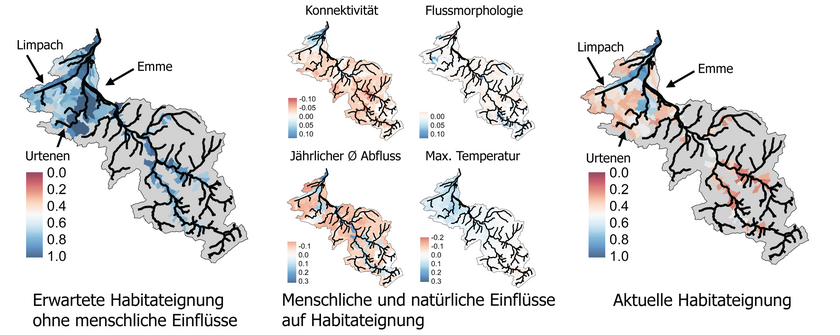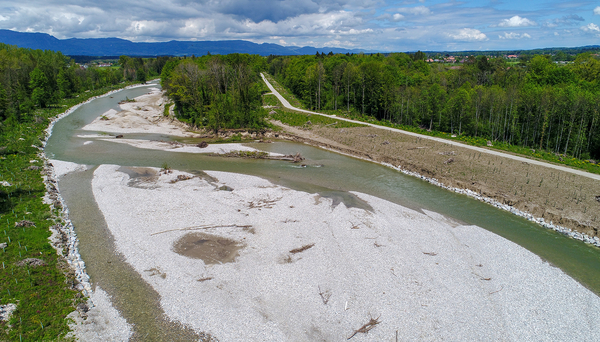News Detail
A list of priorities for the protection of biodiversity
July 9, 2024
Biodiversity is declining at a historically unprecedented rate, both globally and in Switzerland. This applies in particular to the plants and animals living in and around bodies of water. In Switzerland, 65 percent of native fish species are endangered or potentially endangered; around 20 species have already become extinct in the last 100 years. Of these extinct species, 14 were found only in Switzerland and have now disappeared worldwide. In addition, 62 percent of aquatic insects and over half of the plant species associated with bodies of water are endangered or already extinct.
There are many reasons for the decline in species. They range from the damming of water bodies for flood protection and the use of hydropower to the impairment of water quality by nutrients and pollutants as well as climate change. Switzerland has defined targets and measures in various strategies and laws to halt the decline in species – first and foremost in the Biodiversity Strategy and the associated action plan, as well as in the Water Protection Act. But the implementation of the measures is lagging behind the targets, partly because financial resources are scarce, there are conflicting objectives, and the data on biodiversity and its requirements is incomplete. This makes it all the more important that the measures that can be realised to protect and promote biodiversity are as effective as possible.
Identifying regions with the greatest need for action
This is the starting point for the “Lanat-3” research project, which is funded by the Wyss Academy for Nature, the Canton of Bern and the FOEN and led by researchers from the University of Bern, the Swiss Competence Centre for Fisheries and the aquatic research institute Eawag. The aim of the project is to identify the regions where the need for action to protect aquatic biodiversity is greatest and to plan protection and supporting measures there in the best possible and most targeted way. The researchers are focusing on fish and aquatic insects and initially on the Aare and Rhine catchment areas.
In a first step, they recorded and modelled where and which fish and aquatic insect species occur in the catchment area. This is based on surveys of the occurrence of species. From the locations where they are found, it is possible to deduce which environmental factors a particular species needs in order for a site to be suitable for it. For example, we know from fishing that the schneider (or spirlin) fish prefers fast-flowing, oxygen-rich rivers and spends its time in areas free of obstacles. This knowledge can then be used to extrapolate the occurrence of the schneider to locations for which no species surveys have yet been carried out. This is based on maps of environmental factors in the entire catchment area of the Aare and the Rhine – including temperature, flow rate and the degree of urbanisation.
In this way, suitable locations in the catchment area were identified for around 50 species of aquatic insects and 40 fish species. The maps below show that the diversity of aquatic insects tends to be highest in smaller rivers and at higher altitudes, while lakes, larger rivers and their unobstructed tributaries at low and medium altitudes are home to the most fish species.
Which environmental factors have the greatest influence on the occurrence of species?
At the same time, this data can also be used to determine which environmental factors have the greatest positive or negative influence on the occurrence of a particular species. To do this, the researchers used artificial intelligence-based models (AI) to simulate what the distribution of species would look like without human influence – i.e. in natural rivers with an environment free of human development. This makes it possible to see where the difference between the actual and theoretically expected occurrence of a species is greatest and which factors are decisive for the difference.
In the first part of the project, which was launched in 2020, the researchers focused on the Lower River Emme region, which stretches from Burgdorf (canton of Bern) and Zuchwil (canton of Solothurn). The figure below shows the results of the simulations for one of the fish species analysed, the schneider. The lack of river continuity due to obstacles (“connectivity”) has a particularly negative impact on the occurrence of this fish species. The flow rate, on the other hand, is well suited for the schneider, at least along the main axes of the Lower River Emme water system, but less so in the tributaries to the River Emme. The water temperature, another factor analysed, is in a good range for the schneider, while the river morphology has hardly any influence on its occurrence.

These results therefore show that the fish passage of the River Emme and its tributaries must be prioritised in order to enhance the occurrence of the schneider. The models even make it possible to determine in detail which obstacles need to be removed in order to achieve the greatest positive effect.
The same can be determined not only for the schneider, but for the entire species community in a region. How different species react to environmental factors can vary greatly. In this way, cantons and communes can plan and implement measures precisely where they contribute most to the protection and promotion of biodiversity.
Extension to other species in the second project phase
In the second phase of the project, which has now started, the researchers would like to include even more species in their models in order to further improve their validity and, above all, to be able to protect all species. “To do this, we want to examine species groups in detail which have not yet been differentiated and study them on site in bodies of water in order to understand the needs of these species,” explains Dario Josi, co-leader of the research project at Eawag and the University of Bern. They also want to include the influence of climate change and determine in which regions within the Aare-Rhine catchment area the greatest loss of species is to be expected as a result and which regions will thus become more important refuges for biodiversity.
Two such regions with a great need for action are soon to be selected as pilot regions, in which the findings from the research project should help the cantons to set the best possible priorities when planning revitalisation measures. However, the project aims to go one step further and support the pilot regions in implementing revitalisation projects in the best possible way. To this end, the researchers will determine which stakeholder groups need to be involved and try to optimise their exchange of information and cooperation. In this way, the research project should help to counteract the decline in species where it will have the greatest impact and also initiate the necessary measures as quickly and efficiently as possible. Ultimately, the aim is to test a workflow that will be made available to the cantonal revitalisation planners at the end of the project.
Original publication
Aeschlimann, A., Fehle, P., Neuhaus, M., Ingold, K., Fischer, M., Zinn, N., Wegscheider, B., Waldock, C., Calegari, B.B., Josi, D., Seehausen, O. (2024). Den Biodiversitätsverlust der Gewässer stoppen – trotz Klimawandel. Zwischenbericht Phase I (2020-2023): Projekt LANAT-3, Wyss Academy for Nature Hub Bern.
Waldock, C., Wegscheider, B., Calegari, B.B., Josi, D., Brodersen, J., Jardin de Queiroz, L., Seehausen, O. (2024). Shadow distributions: Deconstructing the geography of human impacts on species' natural distribution. DOI Preprint https://doi.org/10.21203/rs.3.rs-3738567/v1
Wegscheider, B., Waldock, C., Calegari, B.B., Josi, D., Brodersen, J., Seehausen, O. (2024). Neglecting Biodiversity Baselines in River Connectivity Restoration Impacts Priority Setting. DOI Preprint http://dx.doi.org/10.2139/ssrn.4805463
Cover picture: The implementation of measures to protect biodiversity is lagging behind the targets – which makes it all the more important to plan revitalisation measures as optimally and purposefully as possible, like here on the River Emme near Utzenstorf (Photo: Luftaufnahmen Röthlisberger).
Financing / Cooperations
- Eawag
- University of Bern
- FOEN
- Canton of Bern
- Wyss Academy for Nature
- Swiss Competence Centre for Fisheries (SKF)



